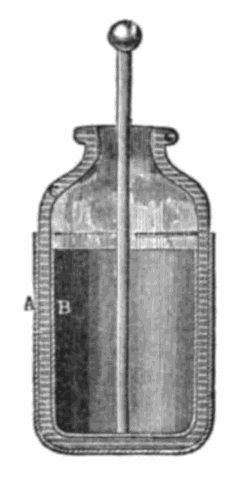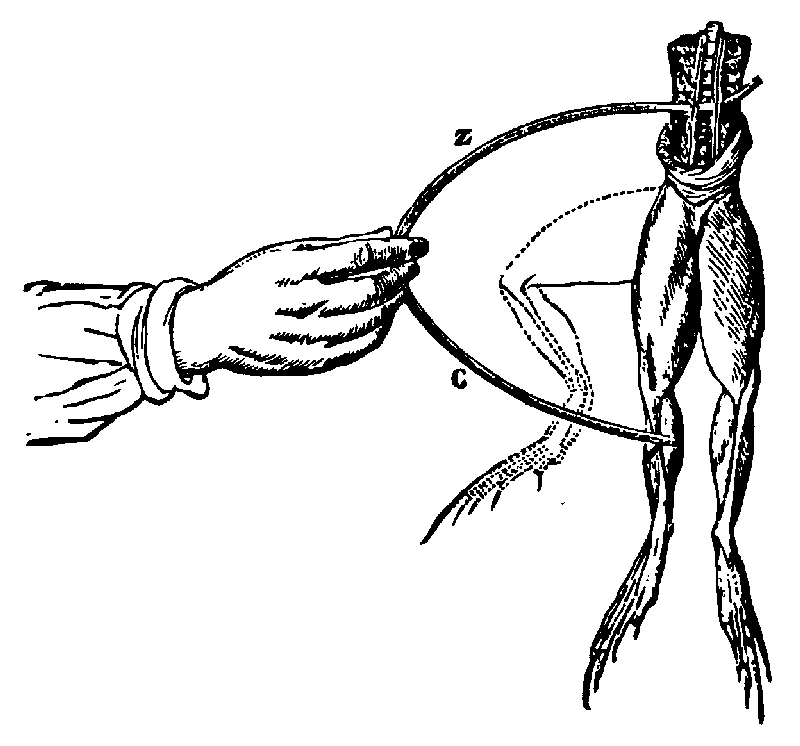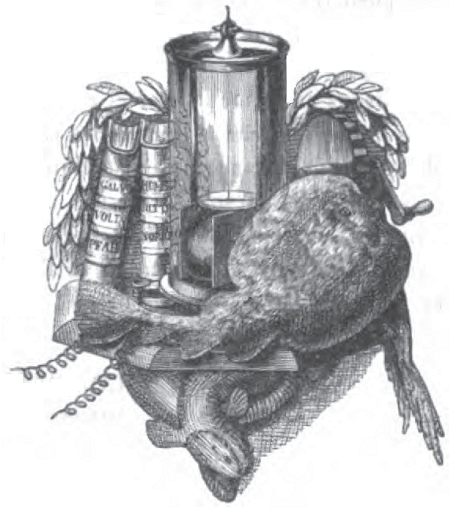Short History of Bioelectrics
There is quite some overlap of Bioelectrics with the field of Bioelectromagnetism (and its derivatives). Hence, both Bioelectrics and Bioelctromagnetism can claim a common ancestry.
If a distinction needs to be made at all, the strength of the stimuli that are investigated can help as a guidline. In Biolectrics the stimuli are rather strong (e.g. electric fields
of megavolts per meter) or seem harh (such as plasma jets), whereas stimuli that are investigated in Bioelectromagnetism usually adhere to the 'priniciple of reciprocity.'
Consequently, the timeline below describes achievments and milestones that are important for both areas and beyond. In fact until the late 18th century, the study of electrical phenomena
in general was strongly entangeled with life sciences and many discoveries on the nature of electricity are owned to this interaction. This is exemplified by by the dispute between Galvani
and Volta, who to this day are famous for their frog-experiments, from which, however, the understanding of
electricity has probably benefited more than the understanding of electrical phenomena in the body.
Prehistoric and Antique Bioelectrics
| 4000BC | According to J. Malmivuo and R. Plonsey, Bioelectromagnetism: Principles and Applications of Bioelectric and Biomagnetic Fields, Oxford University Press, New York, NY 1995,
Egyptian hieroglyphs describe electric shetfish as "fish that releases the troops". This would be the earliest recorded medical application of electric shocks.
(Unfortunately a research by the librarians at Old Dominion University and at the Library of Congress, could not confirm Malmivous' reference to
Charles E. Morgan, Therapeutics, William Wood and Co., New York, 1864.)
|
|
| ~45AD | Morgan also ascribes the first written record of a medical electric treatement to Scribonius Largus, who was the physican of Roman emporer Tiberius:
"For any type of gout a live black torpedo should, when the pain begins, be placed under the feet. The patient must stand on a moist shore washed by the sea and he should stay like this until his whole foot and leg up to the knee is numb. This takes away present pain and prevents pain from coming on if it has not already arisen. In this way Anteros, a freeman of Tiberius, was cured...."He apparently describes a practice that was practiced for a while, therefore it would not surprise if the Egyptians had already used the fish for that purpose. However, the treatments was not necessarily common knowledge, as records from his colleagues show, which point out, that they found that the fish has to be alive for the treatment to work. |
Classic Bioelectrics
| 1672 | I like to think that the classic area of Bioelectrics probably started as an accident (as they still happen today), when researchers played with the first electric
machines. The first one of these was invented by Otto von Guericke (who is more famous for his research on the 'nature of the vacuum').
Keep in mind that during his time - almost 100 years before the French Revolution stirred up the political order in Europe and settlers just tried to get a foothold in the new Americas
- 'natural philosophy' was mostly a distraction for the rich and bored. (Also sythetic fabrics didn't yet
exist, therefore, it was impossible to charge yourself by shuffeling over carpet and discover electricity this way - not that anyone had heard of putting carpets on the floor instead of walls.)
|
|
| 1729 | Once the means were available, mens' curiosity set out to understand the strange phenomena that were associated with 'electricity'. Stephen Gray (1666-1736)
discovers that electricity can flow much like fluids, although not knowing what it is that actually flows, names this fluid the ‘electric virtue’.
|
|
| 1747 | Benjamin Franklin (1706-1790) comes to the conclusion that there are actually two different 'electrical fluids', which he hypothesized to be made up of particles.
|
 |
||
The cutaway shows a capacitor with two metal foils A and B insulated from each other by the glass of the Leyden jar.
|
| 1744 |
While Franklin's thoughts were a theoretical breakthrough, the experimental breakthrough that propelled the study of electrical phenomena was the invention of the Leyden jar by Edwald Georg von Kleist.
Independent from him, Pieter van Musschenbroek at the University of Leyden in the Netherlands also accomplished this task only a year later. (In this age, paper - mostly books - and personal interaction - often in societies - were
the only means for sharing findings. Print and distribution could take months; not to mention the tedious processes of writing the book or making figures from handcut copperplates.) With this capacitor, it was now possible to accumulate and store 'electricity'.
|
| 1747 | Sure enough, as soon as the Leyden jar was available, it was used in Bioelectrics. Jean Jallabert (1712-1768), professor of experimental philosophy and mathematics at Geneva, applied successfully
electric stimulation from a Leyden jar to patient who was paralyzed in his right arm 14 years earlier. However, after this extraordinary success he never reported on another treatment. (It is hard to beleive though, that he didn't try again.)
On a side-note: At this time, the painful sensation when touching an electric machine or a Leyden jar or maybe the inensity of the spark during discharge were maybe the only way to quantify 'electricity'. Other methods and devices did not exist.
|
| 1754 | The potential of 'electroshock-therapies' raised also the interest of researchers in the 'New World'. Benjamin Franklin notes in 1754:
"Some years since, when the newspaper made mention of great cures performed in Italy or Germany, by means of electricity, a number of paralytics were brought to me from different parts of Pennsylvania and the neighboring provinces to be electrified; which I did at their request ... I do not remember that I ever saw any amendment after the fifth day; which the patients perceiving, and finding the shocks pretty severe, they became discouraged, went home, and in a short time relapsed."It is not entirely surprising that Franklins sounds a little skeptic about this application of electricity. Within short time this new technology was not only of interest for serious researchers, who didn't knew what they were doing, but also of many charlatanes and con-man, who probably knew exactly what they needed to do to make money. |
| 1781 | The birth-place of Bioelectics/Bioelectromagnetism as a scientific discipline was likely in Bologna, Italy and started with a series of experiments by Luigi Galvani (1737-1798) bringing frog legs to twitch with a metal arc. However, this metal arc had to be composed of
2 different metals. Galvani concluded that electricity is generated in the animal and that with this special metal arc this 'life-force' can be discharged, which makes the leg twitch. (Why would it twitch on discharge?) Acording to legend, he discoverd the effect originally when disecting
a frog with a metal scalpel on a table where he also had an electric machine. Between 1786-1791 he conducted meticolous experiments (supposedly costing several thousand frogs their lifes) to formulate his theory of 'animal electricity'.
|
 |
||
Illustration of Galvani's twitching frog leg, when touching it with an arc made of zinc and copper.
|
| 1788 | Charles Kite recommended electrical shocks from a Leyden jar, applied to the chest to revive a stopped heart.
|
| 1800 | A contemporary of Galvani and fellow Italian, Count Alessandro Volta (1745-1827) did not agree with Galvanis' explanation on why the frog leg twitches. He had developed alternative means to
measure currents and voltages (although he didn't call them 'voltages' yet) and could show that two dissimilar metals stacked together (a voltaic pile) can
drive a current through an (electrolytic) conductor and that the frog-leg in Galvani's experiments merely serves as such conductor by replacing it with
brine soaked paper.
|
| 1804 | Undisturbed by the academic dispute between Volta and Galvani, the intriguing medical possibilities of electrical stimuli were
further explored. Jean Aldini (1762-1834), Galvani's nephew and collaborator, performed a series of public experiments upon the bodies of executed
murderers using a voltaic pile. He found they retained muscular irritability for two hours after death, and that he could excite many of the motions of
life. Eventually he also revived a dog, which he had suffocated to cardica arrest, with shocks from a voltaic pile.
|
| 1818 | For everybody else, experiments, such as performed by Aldini, were very unsettling and the 'animal electricity' drained by Galvani and put back by Aldini to mimick life, was understandably soon
associated with the 'life force'. The discomfort with the implications, cumulate in Mary Shelly's Frankenstein, which arose out of the spirit of these times:
In the introduction to the 3rd edition (1831) she wrote:
"Perhaps a corpse would be re-animated; galvanism had given token of such things." |
In the meantime, electrical phenomena were on the one hand becoming even more mysterious and on the other hand were becoming more and more under scientific scrutiny. So far electrical phenomena
have been studied mostly for the effects that they had on biological subjects. More and more they were now studied independent from these:
|
| 1820 | Christian Oerstedt (1777-1851) confirms relationship between electricity and magnetism.
|
| 1827 | Georg Ohm (1789-1854) publishes 'Ohm's law'.
|
Modern Bioelectrics
 |
||
Cover-page illustration of DuBois-Reymonds book "Untersuchungne Über die Thierische Electricität;" published in 1848.
The image shows a Leyden jar in the center, the handle of an induction apparatus is visible on the right side behind it. A torpedo stingray is shown in the foreground and the books to the left carry the names of Galvani and Volta.
|
| 1831 | Michael Faraday’s (1791-1867) invention of the induction coil provides a method to drive a continuous current through tissue and enable new therapies. Treatments with Leyden jars so far were always painful.
|
| 1846 | Emil Heinrich du Bois-Reymond (1818-1896) introduces the induction coil to the study of bioelectric effects. For discoveries, such as the action potential, and metiocolous study of electrical properties
of cells and tissues he is considered the founder of electrophysiology.
|
| 1861 | James Clerk Maxwell (1831-1879) publishes ‘Maxwell’s equations’. (An effort to describe Faraday’s experiments by a concise theory.)
|
| 1888 | Augustus Waller (1816-1870) records the first human electrocardiogram.
|
| 1893 | Jaques d’Asonval (1851-1940) heats living tissue by applying high frequency currents through electrodes or coils.
|
| 1897 | Joseph J. Thomson (156-1940) proves that particles (electrons) are carriers of electric currents.
|
| 1924 | Hans Berger (1873-1941) records the first human encephalogram.
|
| 1932 | Albert Hyman (1893-1972) develops the first artificial pacemaker (which was not yet portable).
|
| 1952 | Alan L. Hodgkin (1914-1998), Andrew F. Huxley (1917-) present an electrical model for the activation process in neurons. (In 1964 both receive the Nobel Price in Medicine together with
John C. Eccles (1903-1997) for their "Discoveries concerning the ionic mechanisms involved in excitation and inhibition in the peripheral and central portions of the nerve cell membrane."
|
| 1957 | R. Staempfli and M. Willi report on electrical induced changes (destruction) of cell membranes (confirming earlier findings of Frankenhaeuser and Widen). In particular they measured changes in membrane conductivity and membrane potential. They further found that membrane damage is irreversible if the applied 'electrical shocks' are longer but otherwise the membrane is restored to its original characteristic.
|
| 1964 | Wison P. Menashi files for a patent "Treatment of Surfaces" using a plasma for the sterilization of surfaces "which do not lend themselves to [...] heating."
The patent was awarded 1968.
|
| 1968 | A.J.H. Sale and W.A. Hamilton investigate the non-thermal effect of electric fields on the killing of bacteria. They propose that strong electric fields lead to conformational changes in the plasma membrane, having a permeabilizing effect. Based on electromagnetic theory they developed the charging model for cells, today known as Schwan's formula.
|
| 1972 | E. Neumann and K. Rosenheck observe the reversible electroporation of cell membranes. In a seminal paper of 1982 Neumann coins the term 'electroporation'.
|
| 1974 | U. Zimmerman concludes after a systematic studies of different conditions for duration and strength of an applied electric field, that membrane permeabilization occurs when the transmembrane potential reaches a threshold of 1 V.
|
| 1999 | Karl Schoenbach, Stephen Beebe, and Stephen Buescher discover the induction of apoptosis by nanosecond pulsed electric fields in cancer cells.
|
Juergen Kolb, September 2009 (updated November 2009, edited September 2012)
mail to: webmaster@pulsedpower.de